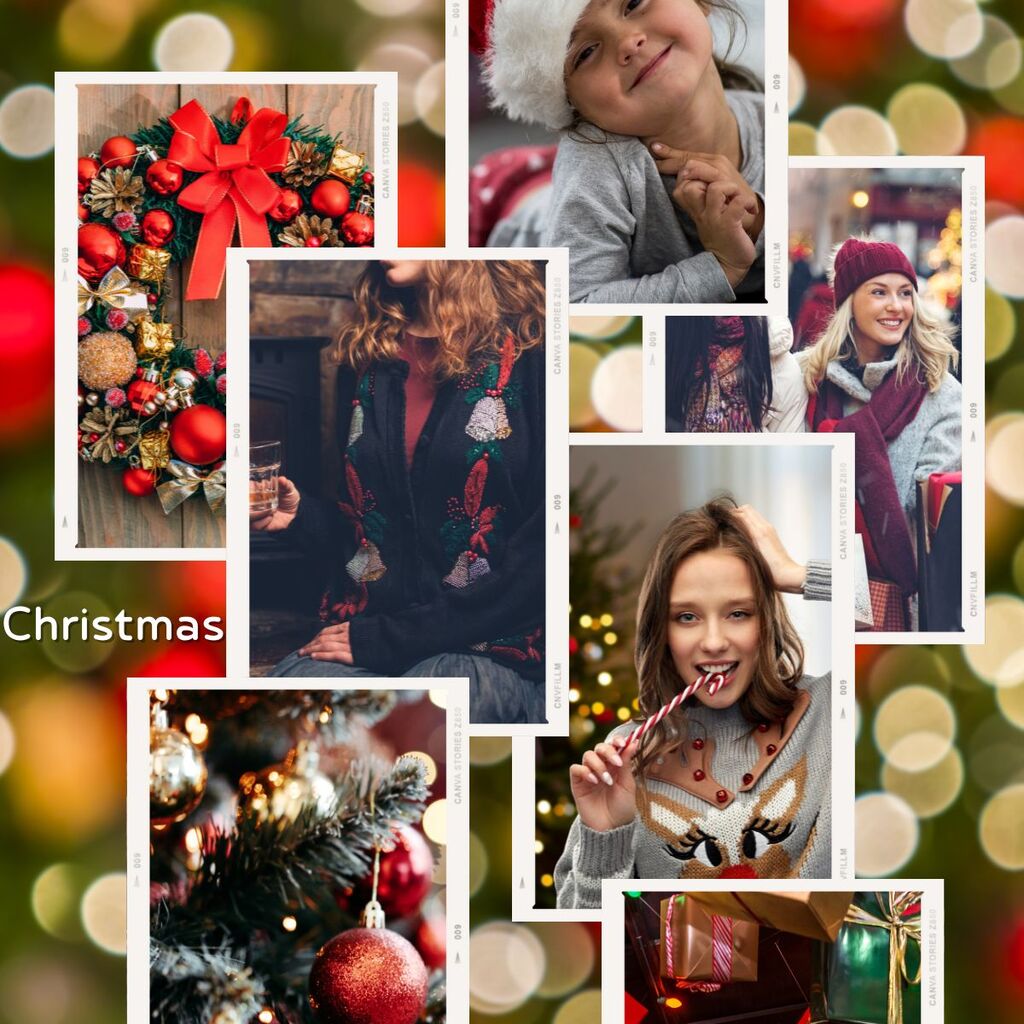Ring the bells! Tra-la-la-la-la (and so forth)! The Christmas aesthetic is a celebration of festivity and warmth, characterized by vibrant decorations, rich colors, and iconic symbols like Christmas trees, wreaths, and twinkling lights. It crafts a cozy and joyful atmosphere, adorned with snowflakes, stockings, and shimmering ornaments. This aesthetic evokes a sense of nostalgia and cheer, bringing families and friends together to revel in the holiday spirit. From glowing fireplaces and garlands to the soft glow of candlelight, the Christmas aesthetic enhances the merriment of the season, capturing the timeless charm and magic that makes the holidays special.

“Christmas isn’t just a day. It’s a frame of mind.”
Kris Kringle, “Miracle On 34th Street”
Do you have a Christmas aesthetic?
Are you nuts about the holiday season? Does the sight of tinsel and wrapping paper get you jumping for joy? Is your reaction to festive snow not “urgh, traffic” but “yay, winter wonderland?” Does the idea of trawling the mall during peak shopping season fill you with excitement rather than dread? Do you just wish you could dress as a cute lil Christmas elf all year round and not be judged for it?
You might well have a Christmas aesthetic – all year round! While Christmas is ostensibly a Christian festival, in reality this style is far more broadly cultural nowadays, fostering a warm, inviting atmosphere that encourages togetherness and celebration, whatever your background. If you love the idea of enhancing and embracing the holiday spirit all year round, creating a sense of magic and wonder, and providing a beautiful backdrop for making new, treasured memories, then the Christmas aesthetic might just be the one you’ve been looking for – whatever the time of year!
Key characteristics of a Christmas aesthetic
- Colors: Red, green, gold, and white dominate the Christmas palette. Red and green symbolize holly berries and evergreen plants, while gold evokes elegance and white represents snow and purity. Occasional accents of silver and icy blues add a frosty, wintery feel.
- Textures and Materials: Warm, soft textures take center stage—think chunky knit blankets, velvet ribbons, and rustic wood accents. Glittering ornaments, glass baubles, and snowy flocked trees add sparkle and dimension.
- Decorations: Evergreen garlands, fairy lights, Christmas trees, and stockings are quintessential to this aesthetic. These are often paired with handmade ornaments, candles, and seasonal motifs like reindeer, snowflakes, candy canes, and nutcrackers.
- Imagery and Themes: Christmas invokes scenes of snow-coated rooftops, crackling firesides, caroling children, and bustling holiday markets. Key themes include giving, hope, and the miracle of the season, all complemented by cheerful or romantic imagery.
- Scents and Sounds: Pine, cinnamon, cloves, and mulled wine define the sensory aspect of the Christmas aesthetic, while classic carols and festive jingles fill the atmosphere with familiarity and cheer.






A short history of the Christmas aesthetic
The Christmas aesthetic, as celebrated in the United States and most of the developed Western world, has deep roots intertwined with various cultural traditions and historical transformations. The origins of this festive aesthetic can be traced back to European customs, particularly the ancient Yule celebrations of the Germanic peoples and the folklore surrounding St. Nicholas in Christian Europe.
Yule, a winter festival celebrating the rebirth of the sun, contributed elements like the use of evergreen trees and wreaths. These symbols of life and renewal were integrated into the Christmas aesthetic over time. St. Nicholas, known for his benevolence and gift-giving, inspired the figure of Santa Claus, a central character in modern Christmas imagery.
The Victorian era witnessed significant changes in the Christmas aesthetic, with Queen Victoria and Prince Albert popularizing the Christmas tree in the mid-19th century. It also gave rise to many of the iconic Christmas visuals we cherish today, with Charles Dickens’ A Christmas Carol popularizing scenes of snow-covered streets, roaring fireplaces, and cheerful merriment. The addition of Christmas trees, inspired by German customs, and the introduction of greeting cards, helped craft what has become the “modern” Christmas aesthetic.
As the Christmas aesthetic evolved, it embraced elements of nostalgia and warmth, becoming synonymous with family gatherings and festive cheer. The 20th century brought more modernization, with electric lights replacing candles, making it safer to illuminate trees and homes extensively. The introduction of plastic ornaments and tinsel added a new dimension to holiday decor, making it more accessible and diverse. Classic Coca-Cola advertisements featuring Santa Claus firmly established a universal visual language for the holiday
These days, the Christmas aesthetic has expanded far beyond traditional decorations to influence fashion, lifestyle, and media. Holiday-themed clothing, such as “ugly” Christmas sweaters, has become a popular trend, embodying both humor and festivity. Media, including movies and music, play a crucial role in perpetuating the Christmas aesthetic. Films like “It’s a Wonderful Life” and “Home Alone” along with timeless carols, continue to evoke the spirit of the season, reinforcing its visual and emotional appeal.
The Christmas aesthetic also promotes a festive and joyful image, encouraging community and togetherness. Homes and public spaces transform into winter wonderlands, adorned with lights, garlands, and seasonal motifs. This transformation not only enhances the holiday spirit but also provides a comforting and familiar backdrop for celebrations.
In recent years, the Christmas aesthetic has incorporated modern influences while maintaining its classic roots. Sustainable and DIY decorations have gained popularity, reflecting growing environmental consciousness. Additionally, the aesthetic has adapted to diverse cultural expressions, embracing various traditions and practices that enrich the holiday experience. The influence extends to marketing and retail, where it drives consumer behavior and seasonal sales. The sight of festive displays and holiday-themed products signals the arrival of the season, creating a sense of urgency and excitement among shoppers.
Cultural impact
- Home Decor: Few holidays inspire as much decorating enthusiasm as Christmas. Annual trends combine traditional elements with modern twists, such as monochromatic decorations or rustic, Scandinavian-inspired styles.
- Art and Media: Illustrations like those of Norman Rockwell capture the heart of Christmas tradition. Iconic holiday movies (Home Alone, The Polar Express, Elf) bring the aesthetic to life through storytelling and meticulous set designs filled with Christmas cheer.
- Fashion: Christmas sweaters, often bold and playful, are a seasonal staple. Velvet dresses, sequined skirts, plaid scarves, and cozy knits echo the warm and joyful essence of Christmas.
- Food and Beverages: Holiday aesthetics influence festive recipes, from elaborately decorated cookies to candy cane-themed treats. Hot cocoa topped with marshmallows or gingerbread-spiced lattes become part and parcel of the Christmas experience.
- Pop Culture: Whether in advertisements, holiday albums, or gift packaging, the Christmas aesthetic has become inseparable from consumer culture. Brands tap into its nostalgic and comforting appeal to create products and campaigns that resonate emotionally with audiences.
Examples of the Christmas aesthetic
- Literature: Books like Dickens’ A Christmas Carol and Dr. Seuss’s How the Grinch Stole Christmas! are timeless literary embodiments of the aesthetic.
- Movies and TV Shows: Films like The Holiday, It’s a Wonderful Life, and animated classics like Rudolph the Red-Nosed Reindeer immerse audiences in quintessential Christmas imagery.
- Music: Holiday classics like Bing Crosby’s “White Christmas” and Mariah Carey’s “All I Want for Christmas Is You” create an auditory landscape that amplifies the aesthetic.
- Brands and Imagery: Coca-Cola’s portrayal of Santa Claus, first introduced in the 1930s, remains a defining visual. Department stores such as Macy’s also showcase elaborate window displays each year, bringing magical, holiday-themed scenes to life.
Make it yours
To gather more inspiration, check out curated Pinterest boards filled with stunning Christmas decor ideas or follow holiday-themed creators on Instagram and TikTok. Explore classic Christmas books and movies to deepen your connection with the season’s aesthetic. For craft inspiration, blogs dedicated to DIY holiday projects offer plenty of creative tips. Holiday playlists on Spotify or YouTube can set the tone for a perfectly festive backdrop to your celebrations, whatever the actual time of year!
- Decorating Your Space: Invest in timeless holiday decor like twinkling lights, wreaths, and ornaments. Layer in cozy seasonal touches such as plaid blankets, scented candles, and fairy-lit garlands for a warm atmosphere.
- DIY Projects: Try making your own wreaths, personalized ornaments, or gift wrap with festive stamps or ribbons. Baking cookies to decorate or crafting garlands from dried oranges are great ways to combine creativity with tradition.
- Fashion: Bring the holiday spirit into your wardrobe with fair isle sweaters, jewel-toned velvet, and warm scarves. Accessories like mittens in Christmas colors or snowflake jewelry can subtly nod to the aesthetic.
- Home-Baked Goodies: Prepare holiday treats like gingerbread houses, candy cane cookies, or festive cupcakes. Hot drinks garnished with whipped cream and cinnamon sticks make for Instagram-worthy holiday vibes.
- Lifestyle Touches: Create an ambiance with Christmas music playlists or watch festive movies while wrapping gifts or decorating the tree. For a full aesthetic immersion, opt for seasonal scents and aromas through cooking or aromatherapy diffusers.
The Christmas aesthetic is an enduring symbol of joy, nostalgia, and human connection. Its mix of vibrant yet cozy visuals, timeless traditions, and heartfelt themes make it universally beloved. From flickering candlelight to snow-laden pines and the warmth of family gatherings, this aesthetic invites us to slow down and appreciate moments of togetherness and cheer. As the holiday changes over time, so does the aesthetic, blending nostalgia with more modern trends in different proportions for each generation. Whether reveling in vintage red-and-green patterns or pairing minimalist decorations with natural hues and elements, the Christmas aesthetic remains a uniting force during the holiday season.
Whether classic or more moern, Christmas embodies a blend of historical traditions, modern innovations, and a surprisingly broad cultural significance. It creates an atmosphere of joy and nostalgia, fostering a sense of belonging and celebration. Whether through timeless decorations or contemporary adaptations, the Christmas aesthetic continues to be a powerful force in shaping how people experience and enjoy the holiday season. So whether you’re a huge nostalgia fiend, are addicted to that magical and generous feeling, or just love all that glitters, there’s plenty to embrace all year around. Ho, ho, ho for all!